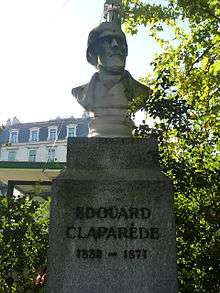René-Édouard Claparède
René-Édouard Claparède (24 April 1832 in Chancy – 31 May 1871 in Siena) was a Swiss anatomist.[1] The Claparède family was Protestant and originally from Languedoc. They moved to Geneva after Louis XIV:s Edict of Fontainebleau in 1685.
He received his education in Geneva and Berlin, where he attended lectures given by Johannes Peter Müller.[1] Later on, he served as an assistant to François Jules Pictet de la Rive at the Geneva Academy, where in 1862 he became a professor of comparative anatomy. He was a regular contributor to the Archives des sciences physiques et naturelles.[2]

His main research dealt with the structure of infusoria, the anatomy of annelids, the histology of earthworms, the embryology of arthropods and the evolution of spiders.[2] Species with the epithet of claparedii commemorate his name, an example being the sea anemone Edwardsia claparedii.[3] Claparède stressed the importance of studying and illustrating living or recently killed organisms and he did not deposit any museum specimens. He died aged 39 from tuberculosis.
Selected works
- Anatomie und Entwicklungsgeschichte der Neritina fluviatilis, 1857 – Anatomy and developmental history of Neritina fluviatilis.
- Études sur les infusoires et les rhizopodes, 1858 (with Johannes Lachmann) – Studies of infusoria and rhizopods.
- De la formation et de la fécondation des œufs chez les vers nématodes, 1859 – The formation and egg fertilization in nematode worms.
- Recherches sur l'evolution des araignées, 1862 – Research on the evolution of spiders.
- Recherches anatomiques sur les oligochètes, 1862 – Anatomical research on Oligochaeta.
- Beobachtungen über Anatomie und Entwicklungsgeschichte wirbelloser Thiere an der Küste von Normandie, 1863 – Observations on the anatomy and evolution of invertebrates from the coast of Normandy.
- Les annelides chétopodes du Golfe de Naples, 1868 – On Chaetopoda annelids from the Gulf of Naples.
- Recherches sur la structure des annélides sédentaires, 1873 – Research on the structure of sedentary annelids.[4]
References
- 1 2
 Chisholm, Hugh, ed. (1911). "Claparède, Jean Louis". Encyclopædia Britannica. 6 (11th ed.). Cambridge University Press. pp. 422–423.
Chisholm, Hugh, ed. (1911). "Claparède, Jean Louis". Encyclopædia Britannica. 6 (11th ed.). Cambridge University Press. pp. 422–423. - 1 2 Claparède, René-Edouard Historischen Lexikon der Schweiz
- ↑ Edwardsia claparedii DORIS
- ↑ Most widely held works about René-Édouard Claparède WorlCat Identities